T-Mobile MyTouch 4G Slide Review - Photographers Wanted
by Vivek Gowri on August 12, 2011 8:45 PM EST- Posted in
- Smartphones
- Snapdragon
- HTC
- 4G
- Mobile
- T-Mobile
- MyTouch
- Slide
When T-Mobile launched the G2, I was super psyched. It was an HTC-designed slider, ran the stock Android UI, and happened to be one of the first phones running Qualcomm’s 2nd-generation Snapdragon (S2) chips. I was so psyched that I ended up buying one, three days before launch (thank you Radio Shack!) I must say, I loved that phone. The hinge mechanism was an initial concern for me, but the rest of that phone was absolutely brilliant. I still regret selling it to buy an HD7, but I had some major durability issues with the hinge. It started loosening up majorly after the four month mark, and it was out of my life by month five. If HTC had seen fit to equip it with a normal spring-loaded slider, I would almost definitely still have it.
T-Mobile EOL’d the G2 last month, and I was sad to see it go. But it set the stage for the MyTouch 4G Slide, which released last week and on paper looks like the ultimate slider phone. There’s one dual-core Snapdragon S3 processor, one real slider with one brilliant HTC keyboard, and one very highly touted 8.0MP camera. It joins the HTC Sensation and the T-Mobile G2x atop the T-Mobile smartphone list.
| Physical Comparison | ||||||
| T-Mobile MyTouch 4G Slide | Motorola Droid 3 | T-Mobile G2x (LG Optimus 2X) | HTC Sensation | |||
| Height | 122 mm (4.8") | 123.3 mm (4.85") | 123.9 mm (4.87") | 126.3 mm (4.97") | ||
| Width | 66 mm (2.6") | 64.1 mm (2.52") | 63.2 mm (2.48") | 65.5 mm (2.58") | ||
| Depth | 14 mm ( 0.55") | 12.9 mm (0.51") | 10.9 mm (0.43") | 11.6 mm (0.46") | ||
| Weight | 184 g (6.49 oz) | 184 g (6.49 oz) | 139.0 g (4.90 oz) | 148 g (5.22 oz) | ||
| CPU | 1.2 GHz Dual Core Snapdragon MSM8260 | 1 GHz Dual Core Cortex-A9 OMAP 4430 | 1 GHz Dual Core Cortex-A9 Tegra 2 AP20H | 1.2 GHz Dual Core Snapdragon MSM8260 | ||
| GPU | Adreno 220 | PowerVR SGX 540 | ULP GeForce | Adreno 220 | ||
| RAM | 768 MB LPDDR2 | 512 MB LPDDR2 | 512 MB LPDDR2 | 768 MB LPDDR2 | ||
| NAND | 4 GB NAND with 8 GB microSD Class 4 preinstalled | 16 GB NAND, up to 32 GB microSD | 8 GB NAND with up to 32 GB microSD | 4 GB NAND with 8 GB microSD Class 4 preinstalled | ||
| Camera | 8 MP AF/Dual LED flash, f/2.2, 1080p30 video, VGA front facing | 8 MP with AF/LED Flash, 1080p30 video recording, VGA (0.3MP) front facing | 8 MP with AF/LED Flash, 1080p24 video recording, 1.3 MP front facing | 8 MP AF/Dual LED flash, VGA front facing | ||
| Screen | 3.7" 800 x 480 S-LCD | 4.0" 960 x 540 RGBW LCD | 4.0" 800 x 480 LCD-TFT | 4.3" 960 x 540 S-LCD | ||
| Battery | Removable 5.62 Whr | Removable 5.65 Whr | Removable 5.6 Whr | Removable 5.62 Whr | ||
The easiest way to describe the MyTouch 4G Slide (referred to as either the Slide or the MT4GS from here on) is that it’s basically a MyTouch 4G with Sensation internals and a physical keyboard. All three are HTC devices, so the use of Qualcomm processors and some form of Sense along with a general recycling of parts is a given, but even by those standards, the accuracy of that statement is striking.
Dimensionally, the MyTouch 4G Slide is pretty similar the original MyTouch 4G, with the Slide adding four millimeters to the width and three mm to the thickness to accommodate the hardware keyboard, but otherwise sharing a very similar look from the front. That three millimeter difference makes a surprisingly big difference in how the Slide feels, it’s definitely a bulky phone compared to the supermodel thin slates releasing currently. Even against another landscape slider like the Droid 3, it definitely feels large.
Now, where this becomes a problem is in how much wasted space there is in the MT4GS design. The Droid 3 and the Slide are basically the same dimensionally, just a fraction here or there separating them - the D3 is 2mm taller, 2mm narrower, and 1mm thinner. And yet, while the D3 has a 4.0” qHD screen, the MT4GS makes do with the same 3.7” S-LCD WVGA display from the much-more-compact G2. Nothing against that screen, it was pretty good looking, but in this day and age, where the average Android device has a 4” screen, the 3.7”er feels a bit cramped. Think about it - Galaxy S/Nexus S, LG’s high end linuep, most of the new Sony Ericsson devices, and the HTC Incredible S are 4”ers, while the Galaxy S II, Sensation/EVO+, Thunderbolt, Droid 3/Droid X2/Droid Bionic are all 4.3”ers. Even the original MT4G had a larger 3.8” display.

I’m usually not a person that makes a big deal out of the whole screen size thing, especially if the resolution doesn’t change, but the amount of wasted space in the MT4GS is fairly maddening. Here’s a device that has a nearly identical footprint to phones with 4” WVGA (Optimus 2X) and 4” qHD (Droid 3) screens, but has to make do with a 3.7” display because a larger panel wouldn’t fit with the design language. In an era of design minimalism, you know something is wrong when you’re using design details to justify functional shortcomings.
The MT4GS aesthetic is very rounded, with a lot of organic curves and tapering edges. The entire display half of the device is ringed by a ribbon of polished metal that tapers inwards, cutting down on the area of the front face. That’s what I’m referring to with “wasted space” - if that taper isn’t there, there’s easily space for a 4” qHD or WVGA screen. Even then, there’s a decent amount of bezel, especially above the display. The space below the display is well used, with four hardware buttons for Home, Menu, Back, and Voice Command, which replaces the traditional Search button, as well as an optical trackpad. But above the display there’s about half an inch worth of dead space between the speaker grille/front facing camera and the display that basically just has the MyTouch logo. It just serves to make the display look even smaller. The metallic speaker grille is a gaudy piece, a chrome intrusion into an otherwise clean front face. The silver-ringed front facing camera, ambient light sensor, and proximity sensor are next to the earpiece, while the lock/power button and the headphone jack are at the top of the phone, where God intended them to be. The left side has the volume rocker near the top, as well as the micro-USB port near the bottom of the phone, with the mics being located on the bottom of the phone. The right side is completely clean except for the two-step camera button, another button that’s quickly being phased out in Android phones.
The battery cover spans the entire back of the device and is rendered in a soft-touch black plastic. Near the top, there is a metal surround for the camera. The camera protrudes from the phone, so there’s a cutout in the battery cover for the lens and dual LED flashes, but the tolerances are much tighter than what we saw in LG’s Optimus 2X. Dust is still a concern, but a relatively minor one. The speakerphone is also located on the battery cover, housed behind a grille near the bottom left corner of the phone.
Unlike with the G1 and G2, HTC went for a real sliding mechanism here. The MT4GS has an in-plane slider that isn’t spring-loaded, but has smooth rails and positive detents at both ends of the travel. The operation feels pretty solid and sturdy enough to hold up over the long term.
The industrial design as a whole borrows a lot from the original MyTouch 4G - from the front, it’s really easy to confuse the two. Some of the very minor details are different - the metal ring around display is larger, the shape of the buttons are very slightly different, the chrome earpiece is now a darker polished metal, but we’re talking about things that are really, really splitting hairs. I wasn’t kidding when I said the ID was basically the same for both devices.
Now with that in mind, look at the similarities between the MyTouch 4G Slide and a much older Android slider on T-Mobile. That’s right, this is the much-maligned Motorola CLIQ (and rightfully so, it was terrible.) The CLIQ was another phone that had a screen too small for the body (read: wasted space), a weird UI skin (Sense 3.0 isn’t as bad as BLUR by any stretch, but we’ll get to the software in a bit), and a rather bubbly-looking industrial design with a lot of soft, rounded edges. The ID isn’t the same, but the MT4GS was definitely “inspired” by the CLIQ. It’s like T-Mobile higher ups were really cut up about the CLIQ’s failure in the marketplace, and had HTC build the ultimate version of that phone. Weird, right?


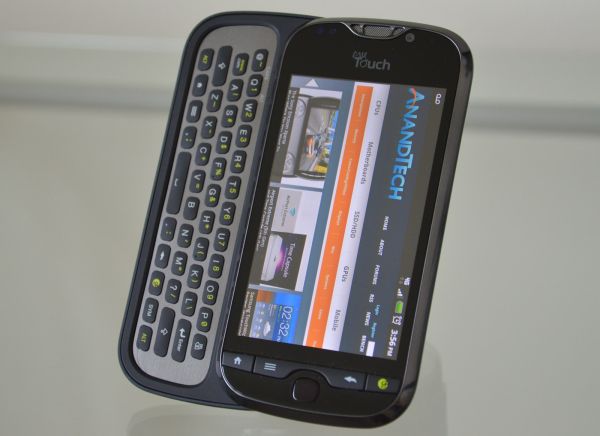
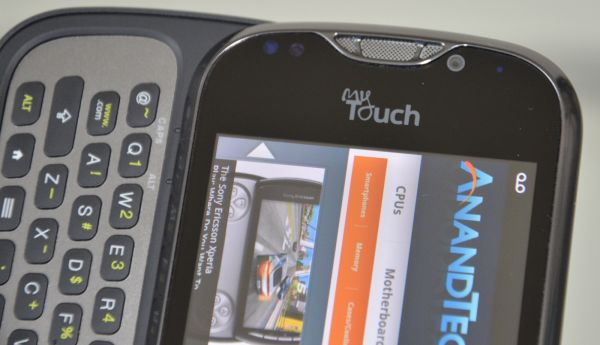
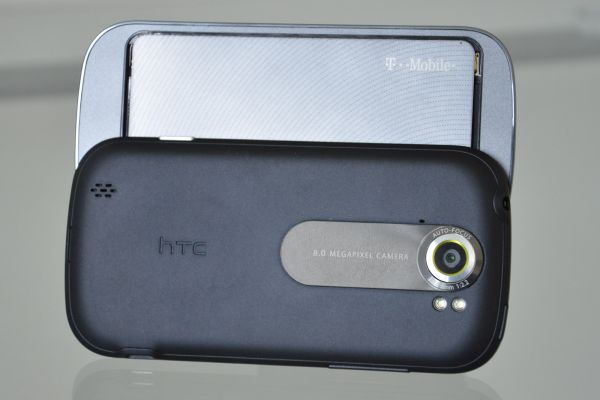
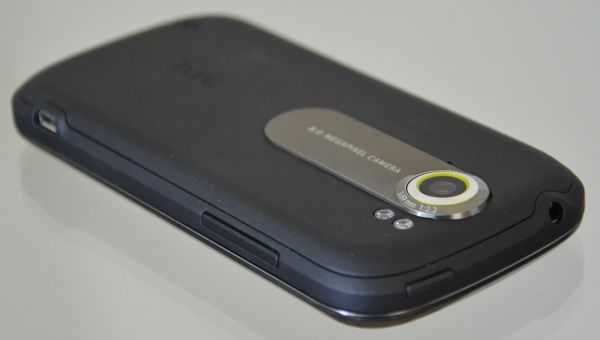


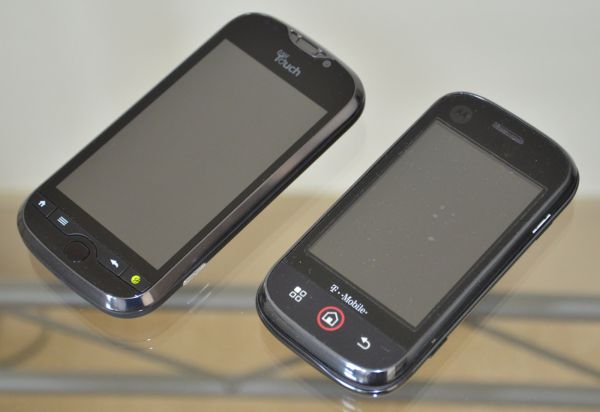








24 Comments
View All Comments
FrederickL - Saturday, August 13, 2011 - link
@Vivek Gowri
Very informative review. With regard to your experience with the 2G I think that the problem may have been that the first shipments of the Desire Z (2G) did indeed have a problem with the construction of that hinge. As far as I can tell (from what I read on various fora at the time) the problem appeared to be largely cured with succeeding shipments. I have had a Desire Z for about half a year now and although the hinge-action has an unusual "feel" to it because of the structural design I have in fact not had any problems with it at all. The disappointment you experienced may be due to the fact that you were an uber early adopter of that phone!
-:)
Frederick
FrederickL - Saturday, August 13, 2011 - link
@Vivek Gown
Another thought just struck me looking at your battery life tests (although I know that this is somewhat off topic). If Nokia manage to produce a WP7 phone with something like the N8's build quality, the camera *and* bring their traditional strengths in call quality and battery life to the table (I am thinking that nobody yet gets seriously near the iPhone's battery life) then they *may* prove the doomsayers wrong. Furthermore if they brought those qualities to one of their classic slider packages I think that even a gentleman like yourself who perhaps feels a touch jaded after seeing so many phones might feel pleased! -:)
VivekGowri - Saturday, August 13, 2011 - link
I definitely agree about the G2 - I went through two in the first week, and they both felt like crap. The later hardware revisions I played with at the T-Mobile store were definitely better, but they still weren't what I would call "confidence-inspiring". I'm comfortable with my decision to sell when I did, but man was that a brilliantly functional phone for it's day.The Nokia WP7 lineup has me so ridiculously excited, you have no idea. I'm an out-and-out Nokia hardware fanboy who has loathed Symbian since the N95 started to get long in the tooth. The first Nokia WP7 device (Sea Ray, the one that looks like the N9) is gonna be bomb, and if they do one like the E7 or the MeeGo slider phone (rumoured to be the N9 back in the day, don't remember the official name off the top of my head), I'll be basically thrilled. I've been using Mango on my HD7 recently, I'm pretty psyched to see it paired with Nokia's brilliant HW design.
dlochinski - Sunday, August 14, 2011 - link
You actually can buy a spring for the g2, (rather cheap and rather strong) and replace the spring inside the g2, then voila, no issues! It is rather unfortunate that it had problems in the beginning, but it is a good phone beyond that.FrederickL - Sunday, August 14, 2011 - link
@Vivek Gowri
Indeed. I currently run my "Z" as my primary and my dear old "Wildfire" as my backup. I will be looking to upgrade my main phone in about a year and as far as I can see my likely choices will be between HTC's then current Android slider and whatever Nokia has presented as its high end WP7 slider. My good lady runs an N8 and as far as the hardware is concerned she loves it but as far as the os is concerned she uses language that would make a Navy Seal blush! I would certainly be looking in about a year (we have an important anniversary coming up) at whatever is then Nokia's flagship cameraphone. All in all the coming year bodes well for choice of good kit in the marketplace. I look forward to it.
Johnmcl7 - Saturday, August 13, 2011 - link
This is the wrong way round:"The lower the F/#, the larger the aperture and the higher the diameter of the lens opening. This gets you a greater depth of field and allows more light to reach the image sensor"
As you widen the aperture the depth of field is reduced, not increased although perhaps that's just the way I read 'greater' to mean deeper depth of field. Either way on such a small focal length the slightly increased aperture isn't really going to have a noticeable effect on depth of field which is going to be very deep anyway.
Thanks for the review although frustratingly while there were rumours of this phone being released in Europe as the HTC Doubleshot (the G2 was released as the Desire Z with Sense intact) I can't see any sign of it on preorder lists so like the Droid 3 it looks like it's not going to be sold here. Which is particularly frustrating given there's no other high end qwerty sliders after the Desire Z.
John
anandtech pirate - Saturday, August 13, 2011 - link
It looks like HTC needs to stop being cheap on the internal storage. 4GB when the standard now is at least 8gb to 16gb.bplewis24 - Saturday, August 13, 2011 - link
Completely agree with the Custom UI rant you threw in there. I hope more reviewers keep harping on it.The Moto D1 had a dedicated camera button that could be long-pressed to open the camera application, so I don't think HTC was copying MS on that one.
Lastly, great review as always. AT is the go-to site for smartphone reviews now. I can't tell you guys how many times I have debunked irrational and subjective criticisms of specific phone/hardware with objective analysis and evidence from these reviews.
VivekGowri - Saturday, August 13, 2011 - link
Yeah, I guess I didn't mean that they were copying Microsoft, but the idea was definitely marketed pretty heavily by the WP7 devices. HTC has put out enough WP7 devices in the last year that taking that feature to Android seems pretty logical.Bristecom - Saturday, August 13, 2011 - link
Good find on the use of two different CMOS sensors. I'd be very interested to see some direct comparison shots and video - particularly in low lighting. I hope you can figure out what sensor the Samsung Galaxy S II uses, although I'm pretty sure it's the S5K3H2.